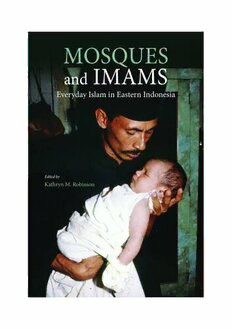
Mosques and Imams Everyday Islam in Eastern Indonesia PDF
Preview Mosques and Imams Everyday Islam in Eastern Indonesia
Mosques and Imams Mosques and Imams Everyday Islam in Eastern Indonesia Edited by Kathryn M. Robinson NUS PRESS SINGAPORE © 2021 Kathryn M. Robinson Published by: NUS Press National University of Singapore AS3-01-02, 3 Arts Link Singapore 117569 Fax: (65) 6774-0652 E-mail: [email protected] Website: http://nuspress.nus.edu.sg ISBN 978-981-325-120-5 (paper) All rights reserved. This book, or parts thereof, may not be reproduced in any form or by any means, electronic or mechanical, including photocopying, recording or any information storage and retrieval system now known or to be invented, without written permission from the Publisher. National Library Board, Singapore Cataloguing in Publication Data Name(s): Robinson, Kathryn May, 1949– editor. Title: Mosques and imams: everyday Islam in eastern Indonesia / edited by Kathryn M. Robinson. Description: Singapore: NUS Press, [2021] | Includes index. Identifier(s): OCN 1144122575 | ISBN 978-981-32-5120-5 (paperback) Subject(s): LCSH: Islam--Indonesia. | Muslims--Indonesia. | Imams (Mosque officers)--Indonesia. | Mosques--Indonesia. Classification: DDC 297.09598--dc23 Cover image: The imam, H. Ahmad Djufri, calls the newborn baby to Islam by whispering the call to prayer in his right ear. Photo by Kathryn Robinson. Printed by: Ho Printing Singapore Pte Ltd Dedicated to James J. Fox Emeritus Professor of Anthropology Australian National University His innovative anthropological approach to studies of Islam in Java, and his ethnographic research in eastern Indonesia have been inspirational for the authors of this volume. Contents List of Illustrations ix Acknowledgements xi A Note on Non-English Words xiii Introduction 1 Kathryn M. Robinson 1. Lebe and Sultan: Serving the Mosque and Sustaining 24 Royal Authority Muhammad Adlin Sila 2. Mediating Religious and Cultural Disputes: 44 Imam Desa and Conflict Resolution in Rural Indonesia Faried F. Saenong 3. Shariaisation, Wedding Rituals and the Role of Imams 64 in South Sulawesi Moh Yasir Alimi 4. A Bugis Imam Desa: An Authoritative Voice in 83 a Changing World Kathryn M. Robinson 5. The Reproduction of Imams and Their Changing Roles 113 within the Contemporary Muslim Community in Wajo, South Sulawesi, Indonesia Wahyuddin Halim 6. Negotiating a Space in the Mosque: Women Claiming 143 Religious Authority Eva F. Nisa vii viii Contents 7. Mosques and their Communities in Northern Ambon, 171 Maluku: Exploring Local Traditions as Islamic Practice in Indonesia Phillip Winn 8. Haji Badar Daeng Pawero: A Bugis Imam and His Roles 194 in Maintaining Islamic Law and Bugis Adat in Kupang Stella Aleida Hutagalung 9. Being Muslim in Eastern Indonesia: Contemporary 219 Patterns of Islamic Practice Andrew McWilliam Glossary 243 List of Contributors 257 Index 258 List of Illustrations Maps Map 0.1 Locations of field studies and significant sites 3 in the spread of Islam in eastern Indonesia Map 8.1 Kampung Oesapa 197 Table Table 9.1 Butonese populations in selected regions of 221 eastern Indonesia (Census 2000) Figures and Photographs Figure 4.1 Imam H. Ahmad Djufri reading the Qur’an 94 at the Majlis Taklim Figure 4.2 Teaching children Muslim religious practice 104 in the Workers’ Mosque (Masjid Karyawan) Figure 4.3 Women watching their children graduate 104 from the TPA (Taman Pendidikan Al-Qur’an) Figure 4.4 Women at the Majlis Taklim in the old mosque 106 Figure 5.1 As’adiyah Tahfiz al-Qur’an (TQMJ) programmes 118 Figure 5.2 A tahfiz student doing his daily memorisation 121 in the main hall of Masjid Jami Figure 5.3 Masjid Jami viewed from K.H.M. As’ad Street 122 Figure 5.4 Tahfiz students lining up after performing magrib 123 prayer to submit their daily memorisation to their teachers in the main hall of Masjid Jami ix x List of Illustrations Figure 5.5 Imam tarawih and mubalig (preachers) ready to 131 be dispatched from the As’adiyah complex in Lapongkoda, Sengkang, to their places of duty in 2012 Figure 5.6 A group picture of students of TQMJ with their 135 director and teachers (Oct. 2012) Figure 6.1 Students at the campus mosque in Makassar 146 Figure 6.2 Female students at their weekly religious 152 programme held in the campus mosque Figure 6.3 Male students of HTI in a special (not regular) 153 public discussion on the caliphate Figure 6.4 A flyer typically found in campus mosques 157 Figure 6.5 Female students greeting and talking to each 160 other before their halaqah Figure 8.1 Al Fitrah Mosque 199 Figure 8.2 Akekah ritual 206 Figure 8.3 Bugis pre-wedding ceremony 209 Figure 8.4 The newlyweds after the Islamic marriage vows 209 Acknowledgements The research for the individual chapters in this volume was conducted by scholars who came together under the umbrella of the project “Being Muslim in Eastern Indonesia: Practice, Politics and Cultural Diversity”. This was funded by an Australian Research Council Dis- covery Project (DP0881464). We acknowledge the vibrant research community of the College of Asia and the Pacific at the Australian National University, and would like to thank the following scholars who participated in our regular discussions and seminars and contri- buted to the development of the approaches to the study of local-level Islam: George Quinn, James J. Fox, Campbell Macknight, Wendy Mukherjee, Virginia Hooker, the late Merle Ricklefs, Luthfi Makhasin, Deni Hamdani and Safira Machrusah. We also acknowledge the con- tribution of Partner Investigator, Nurul Ilmi Idrus. Diana Glazebrook has provided invaluable research assistance including editing this manuscript. Maps are provided by CartoGIS services in the ANU College of Asia and the Pacific. xi
